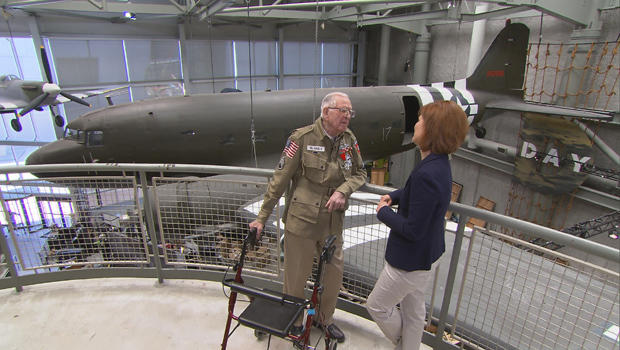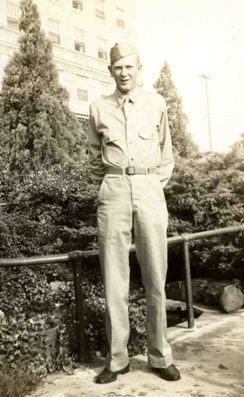A "living artifact" of WWII shares his story
(CBS News) Nearly 68 years have passed since the end of World War II, and first-hand accounts are becoming rare. Anna Werner shares the story of one man who is truly a part of our living history.
While taking a tour of the National World War II Museum in New Orleans, you're advised to look up -- to a B-17 bomber, so deadly and effective it served in every theater of the war.
There's lots to see and hear in this museum of more than 10,000 artifacts and installations, all reflecting the simple fact that WWII was BIG -- the largest armed conflict in human history.
And with all the stuff, it would be easy to miss him, Sitting quietly, just to the right as you enter the exhibit hall.
But that would be a shame.
Mr. Tom Blakey was in the 82nd Airborne. On June 6, 1944, he jumped out of that big plane, around midnight, during the Normandy invasion.
He'll tell you all about his experiences
Staff Sgt. Blakey, 93 years old, volunteers at the museum for a couple of days each week, greeting visitors young and old, sharing his story, answering questions, and inevitably getting his picture taken.
"You want to break your camera?" he jests
He's been sitting there for over a decade now, logging 13,000 hours as a volunteer, so long the museum staff has a nickname for him: They call him the "living artifact." "They call me a lot of other things too. But you don't want to know about those!"
The museum is filled with reminders of his time as a paratrooper with the famed 82nd Airborne -- a photograph of Blakey even hangs in an exhibit.
He was there on the morning of D-Day, parachuting into France behind enemy lines. His mission: To capture and hold a small bridge over the Merderet River, making sure Nazi infantry and tanks could not reinforce the Normandy beaches.
"We were ordered to take that bridge and to hold it, whatever the cost was. We did not let it go," Blakey said. "The cost was high. But the bridge was held. And that kept the Germans from getting to Utah Beach."
It's a story he told many times over the years, but there was one part that he always left out, until now.
"We were at the bridge. They were comin' around the curve. Everybody had got the message, 'Pick one out.' I picked one out. I picked him out, got a site, hand on the trigger, and pulled it. I could see when the bullet hit him. He jumped up in the air, raised his arms above his head, and dropped his rifle and fell backwards."
He kept firing, and many Germans fell that day, and in battles to come. But even after the war ended and Blakey was sent back home to New Orleans, that first man he shot and killed haunted him.
"He came to me from that day on ever so often," Blakey said. "There was never any rhyme or reason when he came and when he left. Sometimes he would do that three or four times, sometimes he'd only do it once. But it was always somethin'. He was always there. And he came vividly in my mind often. It made me belligerent. I've got -- I was mad. I don't know what I was mad at or about. But I was mad.
"I had gotten married, had children, had a mortgage like everybody else did, had a good business. I wasn't belligerent with my employees, my business, or my customers. I got along with all of 'em beautifully. But I did bad things to my family.
"I fussed, I criticized, I don't know why."
He says he was angry for decades, until the museum -- originally called the National D-Day Museum -- opened in 2000, and Tom enlisted as a volunteer.
"I came to the museum and I worked three days a week for about four months," he told Werner.
Walking through those automatic doors, meeting other veterans, and sharing his experiences, Staff Sergeant Blakey underwent a transformation: "I got up one morning, it was on a Wednesday morning, I threw the cover back and got out of bed and it hit me: How long have you been to the museum? Been there four months. You haven't seen the man. He has not appeared. In the four months you've been at the museum, he has not appeared.
"I've been here 13-and-a-half years, and I have lost him. He doesn't appear anymore.
These men from the "Greatest Generation" aren't really the touchy-feely type, and it's hard for Blakey to put into words how the museum helped him lose his anger.
"I don't know what the museum had to do with it," he said, "but I know how I felt when I walked in and I know how I felt when I walked out the front door. And my kids will tell you that my going to the museum was a change in me."
In a museum designed to preserve memories of the war, Tom Blakey managed to let one go.
For more info:
- The National WWII Museum, New Orleans

